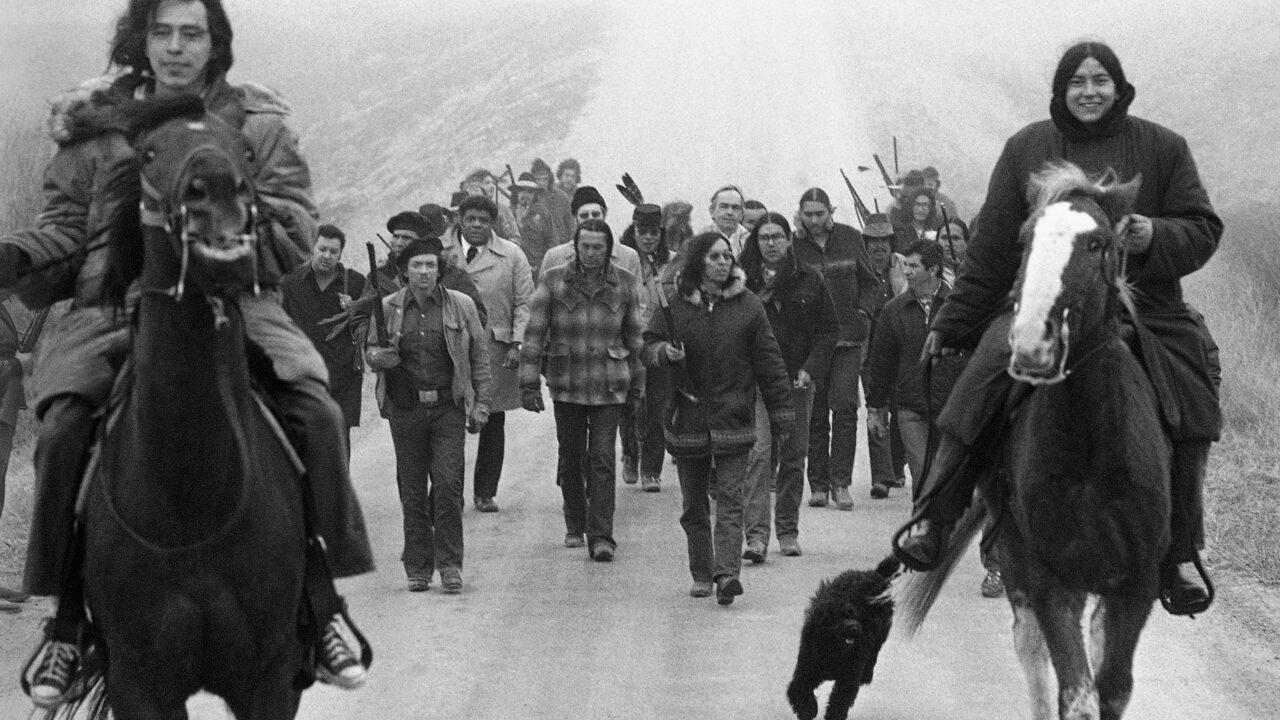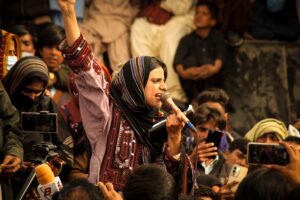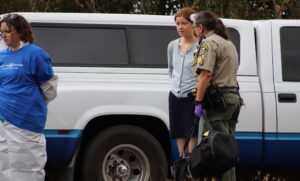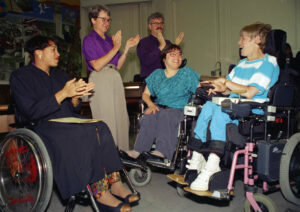Wounded Knee, Fifty Years On
The mission of Indigenous activists continues through their children and grandchildren. Members of the American Indian Movement on March 13, 1973. Photo: AP.
Members of the American Indian Movement on March 13, 1973. Photo: AP.
The world had largely forgotten about Native American people by the early 1970s, said Marcella Gilbert. Native populations had been decimated by disease and colonization; their sprawling homeland where ancestors had roamed was splintered into reservations. The Lakota language was nearly extinct and practicing the Lakota religion was illegal.
“People across the world didn’t even know we still existed,” Gilbert said. “They thought John Wayne killed us all.”
But she said that began to change after South Dakota was put in the national and international spotlight starting on Feb. 27, 1973. On that day 50 years ago, hundreds of Native Americans and Indigenous activists began a 71-day standoff against the U.S. government at Wounded Knee on the Pine Ridge reservation, fighting for Native American recognition and rights. The confrontation and subsequent negotiations with the federal government about treaty obligations were on international display, said Gilbert, daughter of one of the occupation’s leaders, Madonna Thunder Hawk.
“The world became aware that we were still here,” said Gilbert, a member of the Cheyenne River Sioux Tribe. “History exploded in front of their faces.”
Wounded Knee ’73 spurred movements globally and nationwide to recognize Indigenous rights, and the work continues today with the children and grandchildren of the ’73 activists.
“It’s about knowing who we are and how we educate our future generations,” Gilbert said.
Madonna Thunder Hawk is an 82-year-old great-grandmother, a community worker and a member of the Oohenumpa band of the Cheyenne River Sioux Tribe. Fifty years later, she can remember the sounds of gunfire at Wounded Knee.
“It was warfare,” she recalled.
Back then, she was a 32-year-old mother serving as a medic for the American Indian Movement, a grassroots Native American organization started in Minneapolis in 1968. She joined because she was determined to forge a better future for her family and children. She spent “practically every night” huddled in a bunker while AIM members traded gunfire with the federal government.
“To be organized was new and amazing,” Thunder Hawk recalled. “We were younger people then. Any time young people are on the move, change happens.”
AIM was labeled as a militant group by the federal government for its disruptive protests, including a protest in Custer weeks before the occupation about the insufficiency of charges against a white man who killed a Native American man. Eventually, the protest turned into a riot with extensive damage to public property.
The occupation led to the passage of the American Indian Religious Freedom Act and the Indian Child Welfare Act of 1978.
After the incident in Custer, Thunder Hawk traveled to the Pine Ridge reservation with an AIM caravan at the request of Lakota elders on Pine Ridge to discuss corruption on the reservation, she said.
Thunder Hawk assumed the visit would just be a day trip, but the group moved into the small town of Wounded Knee the night of Feb. 27, 1973, taking over the trading post and establishing a base of operations shortly before being surrounded by federal agents.
By the time the siege ended on May 8 with an agreement to disarm and further discuss treaty obligations, at least three people were killed and more than a dozen were wounded.
The occupation became a symbol of Indigenous power, said Beth Castle, a former professor of Native American studies at the University of South Dakota and a director and producer of the 2018 documentary “Warrior Women,” which focused on female leadership during the occupation and in following Native movements. A newspaper photo shows AIM leaders Russell Means, Dennis Banks and Carter Camp (left to right) join hands with a bishop of the United Methodist Church of South Dakota after leaders agreed to a peace proposal. (Courtesy of the South Dakota State Archives)
“Wounded Knee hit every newspaper in the world. It announced this existence and continual survival of Native people,” Castle said.
But the occupation is not a celebratory memory for everyone. The late Tim Giago, who was an Oglala Lakota newspaper publisher and columnist, lived in Wounded Knee as a child in the 1930s. His father was a clerk and butcher at the Wounded Knee Trading Post.
The cabin they’d lived in was burned to the ground during the occupation, Giago wrote in a commentary in 2013. AIM members took 11 Wounded Knee residents as hostages during the occupation, including the owners of the trading post.
“The village is now gone, burned to the ground,” Giago wrote. “The homes and the Trading Post were never rebuilt and the empty streets and burned out homes are stark reminders of the day Wounded Knee was ‘liberated.’”
But Castle said the occupation led to the passage of the American Indian Religious Freedom Act and the Indian Child Welfare Act of 1978, as well as the United Nations Conference on Indians in the Americas, which eventually led to the Declaration on the Rights of Indigenous Peoples signed in 2007.
Thunder Hawk has continued her work in grassroots activism through the Women of All Red Nations, Black Hills Alliance and more, including serving as an elder organizer for the Dakota Access Pipeline protests of 2016 on the Standing Rock Indian Reservation in south-central North Dakota.
Castle said the success of Standing Rock would not have been possible without its predecessor and that current grassroots efforts in South Dakota, such as NDN Collective and Thunder Valley Community Development, are continued efforts inspired by Wounded Knee ’73.
“These efforts are all connected to the sons and daughters of movement organizers and leaders,” Castle said. “They’re the ones that carry the fire on.”
Lakota educators are reclaiming the space that stripped their relatives’ cultural identity now, using it to revitalize Lakota language and culture.
The occupation of Wounded Knee established the resurgence of Native Americans voices. Yet five decades after the occupation, the Lakota language is still dangerously close to extinction. Of the nearly 200,000 Lakota people alive in 2021, fewer than 2,000 were fluent Lakota speakers.
Part of that was due to the forced assimilation of Native American children at Indian boarding schools across the country, said Sierra Concha, a literacy project coordinator at Red Cloud Indian School in Pine Ridge. Red Cloud was formerly the Holy Rosary Mission boarding school where Concha’s grandmother was sent as a child.
Concha’s grandfather, AIM leader and Wounded Knee ’73 activist Dennis Banks, was sent to a boarding school in Pipestone, Minnesota. Sierra Concha poses for a photo with her late grandfather Dennis Banks. (Courtesy of Sierra Concha)
Native children were removed from their families and communities by the federal government in the late 1800s until the mid 1900s and placed in boarding schools where they weren’t allowed to speak in their native language, wear their hair in traditional customs or pray according to their religion.
But Lakota educators are reclaiming the space that stripped their relatives’ cultural identity now, using it to revitalize Lakota language and culture. Red Cloud serves over 500 Lakota students and includes a comprehensive Lakota language curriculum and Lakota language immersion program.
“This work is so important because we’re reclaiming not only our language but our Indigenous knowledge systems — things that come with language and are tied to every part of our identity like songs, prayers and stories,” Concha said. “Our language is the very core of our being and who we are as unique Indigenous people.”
Concha said Banks’ mission was to ensure that native people were “recognized and treated as equals.” Banks died in 2017, but his children and grandchildren continue that work.
Concha works with her mother, Red Cloud Executive Vice President Tashina Banks Rama.
Banks Rama said she draws inspiration from her father Dennis Banks’ example.
“He used to have this phrase: ‘It was my generation’s job to go and beat these doors down and fight our way into these institutions and have native people be heard and recognized. It’s your generation and the next generation’s job to walk into these institutions and work them from the inside with the same mission,’” Banks Rama said.
As an administrator, Banks Rama said she’s able to advocate for change “at the table.”
While much work has been done and there have been improvements, the ultimate goal is tribal sovereignty and self sufficiency.
While the Indian boarding school era is over, Thunder Hawk’s continued mission is to strengthen and reunite Native families. The work stems from her activism in the ’70s.
She called the foster care system a polished and “modernized” version of boarding schools.
More than half the state’s foster children are Native American, even though Native children make up only 12% of the population. And Native American children are nearly three times as likely to be in foster care as other children, according to a 2020 Annie E. Casey Foundation study.
Foster care is “more acceptable to outside society,” but is still a “form of genocide” and colonization, Castle said.
Gilbert serves as director at the Simply Smiles Children’s Village in La Plant on the Cheyenne River Reservation, which aims to improve Indigenous foster care by keeping children in their tribal community instead of placing them in foster families away from the reservation.
The village can house up to 18 children and has hired trained professionals whose full-time job is to care for children in a village setting that provides cultural programming and mental health services.
“Our people have lost so many things because of the oppression of the government,” Gilbert said. “The foster system is an extension of that. They’re still taking our children.”
Thunder Hawk’s mission in the last five decades has always focused on family and child welfare. As a member of the Waśagiya Najin “Standing Strong” grandmother’s group on the Cheyenne River Reservation, Thunder Hawk and Gilbert helped bring Simply Smiles to the community and are working with the tribal council to develop a family restoration program and department through tribal government.
Some of the issues activists fought for in 1973 haven’t changed in 50 years.
While much work has been done and there have been improvements, the ultimate goal is tribal sovereignty and self sufficiency, Banks Rama said.
“Now we have native policy makers, legislators, lawyers and business people – people who understand the system,” Banks Rama said. “Tribes have a better understanding of their sovereignty now and how to assert their sovereignty when dealing with the federal government.” Tatewin Means is the executive director of the Thunder Valley Community Development Corporation. (Courtesy of Thunder Valley)
Tatewin Means, daughter of the late AIM member and spokesman Russell Means, served as the attorney general for the Oglala Sioux Tribe in the 2010s and ran unsuccessfully for South Dakota attorney general in 2018. But she’s stepped away from her role in government to run Porcupine’s Thunder Valley Community Development as its executive director.
Working at the nonprofit allows her the freedom to dream and the autonomy to see those dreams through.
“Liberation. Freedom. That’s always been our collective vision as a nation to reclaim that sovereignty prior to colonization and to get as close as possible to being the spiritual beings and have the way of life we’ve always carried,” said Means, a member of the Sisseton Wahpeton Dakota, Oglala Lakota and Inhanktonwan nations. “It’s still there now because we’ve fought so hard to keep it.”
Means said her father taught her about the occupation as she grew up and how the event “reawakened the strength, spirit and pride to be Lakota and Indigenous.”
“It’s not just the legacy of him or other people, but the legacy that our community left — individuals who sacrificed their lives there and were willing to die so our people could be free from oppression,” Means said. “It’s part of our responsibility to be freedom fighters. It’s who we are; it’s in our DNA.”
Banks Rama said she’s grateful for the work her father and other activists did at Wounded Knee in 1973. Their activism set a foundation for the work Indigenous people across South Dakota and the United States continue today.
“The Lakota people and the Indigenous people across this country are very strong and resilient,” Banks Rama said. “Our youth and the next seven generations are rising.”
This story originally appeared in Minnesota Reformer. Follow Minnesota Reformer on Facebook and Twitter.
Your support matters…Independent journalism is under threat and overshadowed by heavily funded mainstream media.
You can help level the playing field. Become a member.
Your tax-deductible contribution keeps us digging beneath the headlines to give you thought-provoking, investigative reporting and analysis that unearths what's really happening- without compromise.
Give today to support our courageous, independent journalists.






You need to be a supporter to comment.
There are currently no responses to this article.
Be the first to respond.